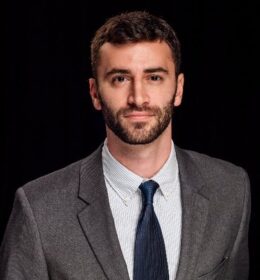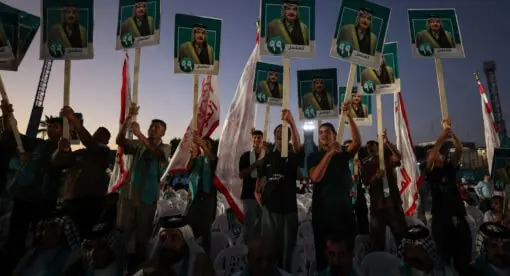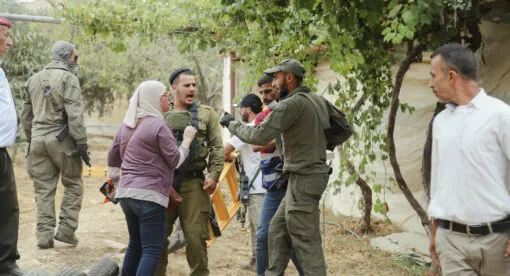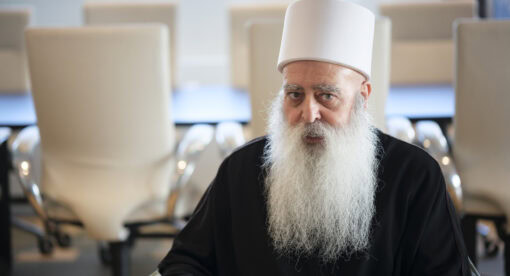To commemorate the two-year anniversary of Russia’s full-scale invasion of Ukraine, host Nick Heras sits down with the New Lines Institute’s Senior Director Eugene Chausovsky. In addition to discussing the present military situation, Chausovsky explains the international tie-ins to the conflict, the possibility of hybrid escalation, and what the future of the conflict looks like.
Nick Heras:
Hello everyone, and thank you for joining us for the latest edition of The New Lines Institute for Strategy and Policy’s Contours podcast series. I’m your guest host, Nicholas Heras, and I’m joined today by our senior director for analytical development and training, Eugene Chausovsky. Eugene also happens to be a world-renowned expert on Ukraine, Russia, and post-Soviet states, and he’s a highly respected geopolitical analyst.
Eugene, thank you for joining us today. I want to start with a broad question. Can you give us the state of play right now, not only in the Ukraine War, as we head onto the unfortunate two-year anniversary of the war, but also the 10-year anniversary of Russia’s initial campaign in Ukraine in 2014?
Eugene Chausovsky:
Absolutely. Thanks, Nick. I would say that the state of play of the war right now, we’ve seen now almost two years of Russia’s full-scale invasion. The war has ground to a stalemate of sorts on the strategic level. Now, we have seen that Ukraine’s counteroffensive, which it launched last year, was not as successful as many in Kyiv and the West had hoped. We have seen more recently that Russia has made some limited tactical gains taking the city of Avdiivka in Eastern Ukraine, but mostly we don’t see a lot of change along the front lines. This has become a very drawn-out conflict, especially over the past few months, and there is no real, major signals for an end in sight anytime soon.
Now, you did point to the broader backdrop as well, which is that this war actually didn’t really start two years ago. Of course, Russia did escalate it significantly, but it really goes back more than 10 years ago with the Euromaidan revolution in Kyiv and Russia’s subsequent annexation of Crimea and the support of separatist conflicts in Eastern Ukraine. Essentially, this has been a much longer war than many give it credit for. It really showcases, I think, a lot of the geopolitical dynamics and a lot of global ripple effects that I’m sure we’ll get into more in this podcast.
Nick Heras:
Thank you, Eugene. I just want to pick up on that last point you gave us because I think it’s really important when we take a step back and we say, “Look, the campaign that Russia initiated in February 2022 was in fact a resumption of the campaign that it had launched in 2014.” In fact, as you’ve pointed out in your work here at the New Lines Institute and other places, there was always fighting that happened along the point of contact and we had what was thought to be a frozen but unfreezing type of conflict, which now of course has metastasized even larger.
I want to also point out, I follow very closely political discussion here in the United States, one of the dynamics that I think also is coming to fore is, when we hear in the press and in the discourses, concept of a long war, aka, a conflict that extends so long that it ultimately costs the United States, from that point of view, too much and therefore risks the United States taking its eye off other situations, such as in East Asia with China or, increasingly in our political discourse here in the United States, on the southern border with Mexico that you see that begin to creep into the discussion.
I’ve noticed with the recent interview that Tucker Carlson, the conservative commentator here in the United States, did with Russian President Vladimir Putin, you saw this just Russian worldview in full bore, where President Putin essentially gave Tucker Carlson a sense of the history of Russia and Ukraine. Interestingly enough, I see coming out of the most recent Munich Security Conference held in Europe, the U.S. and its NATO allies and European Union allies seem to also try to get the sense of, “Hey, look, this is an existential conflict for a rules-based international order that may not be perfect, but it’s better than we’ve ever had in human society.”
That having been said, I want to come back to you on this point of the broader geopolitical context as you see it. How do you see this next year unfolding?
Eugene Chausovsky:
Thanks, Nick. I think you made a very important point in terms of discussing the effects of what has become a long war. As we’ve already mentioned, that war has been raging for the past two years, but also nearly a decade before that. I think what the consequences of that are multiple. One, it does show that Russia, on the one hand, its military was not able to achieve its main objectives in terms of the quote, unquote, “demilitarization or denazification,” of Ukraine that Putin had talked about right up until the launch of February 2022. Russian forces were not able to swiftly invade, sack Kyiv and turn Ukraine into a pro-Russian state. That definitely exposed Russia’s lack of major military strength and on the other hand, it showed that Ukraine was actually a pretty credible fighting force and showed the Western support for it.
Now, fast-forward two years later, the roles have somewhat reversed, in the sense that Russia has, despite those initial setbacks and the exposure of its military, has been able to maintain that fight, has, as we’ve talked about, regained some territory, most recently in Avdiivka, and it is now Ukraine that’s struggling to basically hold the line, so to speak, not just from a military standpoint but from a Western support standpoint, because we saw very, I think, unprecedented support from the U.S. and other NATO countries for Ukraine for much of the initial phases of the military conflict. But now, we’re starting to see that support see some stresses. Obviously, in the U.S., this latest aid package for Ukraine has been held up in Congress for a number of different reasons, some of which you’ve already mentioned.
That is contributing to some of the stresses that Ukraine faces, both from an ammunition standpoint but also from just a broader political backing. Really, the question now is, can the U.S. especially and NATO in particular, with other issues rising to the fore because the Ukraine conflict has lasted in its current phase for two years. Now, you have the Israel-Gaza conflict, you have, as you mentioned, the issue with the Mexico border, and of course the U.S. presidential election coming up. So, can US compete with all of these other issues that are vying for US attention? That’s really the big question, which I think goes to your final question about, what is the outlook?
I think this is really the key question to look forward because whether or not Ukraine is able to basically hold the line, perhaps utilize some of its growing advantages in terms of some of the military support that it did receive, fighter jets, its drone capabilities that it’s been building, things of that nature. This points to Ukraine having some ability to regain the momentum. But we’ve also seen all of the challenges to that from Russia’s own military position to the U.S. backing. So, these I think are the key questions, and of course going into this election at the end of this year, that will really shape the conflict not only this year, but beyond that as well.
Nick Heras:
Thank you, Eugene. It’s interesting, too, because from the point of view of someone like myself, who has a deep background in Middle East analysis, we see now full bore the extent to which, for example, Iran has deepened its alliance, I think we can call it that now, with Russia in terms of supporting the Russian effort to utilize Iranian manufactured kamikaze drones or ammunitions that have been extremely destructive, especially against Ukrainian civilian, but also military targets. But also, the extent to which, as you pointed out, with the Gaza conflict metastasizing in the Middle East, we’ve already seen a lot of concern regarding the extent to which the United States can support Israel, as an example, and Ukraine and potentially Taiwan, this link in of the theaters, if you will, globally from U.S. security analysts.
There’s a lot of pressure now on the European Union, on NATO countries in Europe, to make up the slack, so to speak. You see that, as you’ve pointed out, the domestic political discussion around the 2%. Are NATO countries spending 2% of their total GDP on the military spending? You even see Biden administration officials trying to encourage Europe now. Now, they’ve come around to the idea of europeanization, if you will, of European security. So, I want to take us back to one of the scenarios that you’ve developed, which I think is a really brilliant scenario, although sad of course, is this idea of a hybrid escalation. Can you walk us through what hybrid escalation means and why it’s super important for all foreign and national security policy professionals, but also just the general public, to understand what that context could result in?
Eugene Chausovsky:
Absolutely. When I discuss hybrid escalation, there’s really multiple components to it because we’ve already talked about the military standpoint, that despite Russia’s recent tactical advances, the war on the front lines is more or less at a stalemate. So, if you’re thinking about things like a military escalation, that would entail the conflict intensifying significantly within Ukraine. It could entail spreading beyond Ukraine to perhaps direct Russia-NATO confrontations. Those things I think at this point are unlikely, though you can’t rule out that possibility entirely.
Hybrid escalation, on the other hand, is that gray zone warfare that doesn’t necessarily include only military standpoint, but it can incorporate parts of it. So, just as an example of that, we’ve seen Ukraine, because of its struggles on the battlefield, on the front lines, has really been focusing on and increasing its drone capabilities, both on the domestic front and also in partnership with some of its partners and allies. For example, we’ve seen now Ukraine increasingly target Russia, both in places like Crimea, where Ukraine has really been looking at utilizing its drone capabilities against warships there, but also in Russia proper.
Something that’s really emerged over the past few weeks has been Ukraine targeting Russian energy infrastructure well beyond the border areas between Russia and Ukraine. This includes in places like St. Petersburg, on the Baltic Sea, where there is a lot of Russian energy infrastructure, and all along the western zone of Russia, so to speak. This is, I think in some ways, an echo of what Russia has been doing in Ukraine, not only targeting Ukrainian military sites, but also critical infrastructure.
We saw that especially in the first year, where Russia was basically trying to knock out Ukraine’s energy infrastructure, transport infrastructure, things of that nature. Basically, Ukraine is now taking the fight to Russia, so to speak. But it also entails other non-security forms of contention. We’ve seen, for example, economic statecraft has been a really important part of this war. The U.S. and EU have passed major sanctions against Russia, which haven’t completely wrecked the Russian economy, but they have certainly added economic pressures against Russia.
Increasingly, we’re starting to see how secondary sanctions are really adding further pressure against Russia by countries like China, countries like India and Turkey, which have maintained economic ties with Russia despite the war in Ukraine, are starting to be felt more and more and starting to basically lessen their business, or at least be a lot more focused and cautious on how they conduct business with Russia because of these sanctions. So, everything that goes beyond that line of direct military-to-military conflict is captured in hybrid escalation. Yes, this is something that we’ve seen. This scenario has really increased, especially in the first couple of months of this year.
Nick Heras:
Eugene, I want to build on this point because with this hybrid escalation scenario, I think you also give a lot of space, rightfully, to the human element of geopolitical analysis. One of the dynamics that I have been following closely over the last two years is the dynamic within Russian society and Russian socio-politics. It seems that despite the broad analysis and assessment by many in the public security community, Russia’s will to fight will erode, in fact, it seems the opposite has happened and that although, there’s the famous examples of Russia offering lots of enticements for prisoners in Russian jails to fight in Ukraine, voluntary recruitment has increased dramatically over the last year in Russia for military service. Social media is replete with examples of young Russians embracing this concept of the Z generation. Here in the United States, and as I’ve observed in the European discourse, there’s a lot of an emphasis on Ukraine’s will to fight, which is there. The Ukrainian society has really rallied effectively despite all the pressures against it.
However, on the Russian side, there also seems to be a rallying around the flag effect, and with Russia’s sheer size advantage over Ukraine, the developing dynamic that it seems that China, Russia, Iran, and other partners such as North Korea, the Houthis for example in Yemen, potentially Venezuela in Latin America and some other states are developing this nascent sense of, if not an outright alliance, a cooperative type of venture that seeks to reduce the influence of the United States region by region and on aggregate therefore force the U.S. out of its leading position in global affairs.
From that point of view, a lot of questions will lie on the extent to which both, Ukrainian society and Russian society, are girded for a long existential-type conflict. You have extensive experience in Ukraine and also in the post-Soviet states. What is your read on the zeitgeist, both on the Russian side and the Ukrainian side, for being involved in a hybrid escalation scenario?
Eugene Chausovsky:
It’s a really important question. I think starting with Ukraine, I was just speaking to a Ukrainian contact of mine that’s based in Kyiv shortly before this call, the zeitgeist I think is that that will to fight, that will to stand up to Russia, is still very much there. I think that the majority of Ukraine still feels that and that will continue for quite some time.
Now, I will say, and this is the impression that I got from this conversation, is that the lack of support, or at least the degree of support, from the west, and especially from the U.S., that is taking its toll I think not only from the direct logistical military support, but also from a diplomatic standpoint and from a morale standpoint in a way.
Not to say that Ukrainians will stop fighting, but that it’s a more difficult fight ahead when they’re not sure that their key allies are there to support them in a sustainable way. So, this is I think something that really bears watching very closely. I will note that the EU has just recently passed its own large-scale, I think, 50 billion euro aid package for Ukraine, which I think is an important point, but the U.S. obviously looms very large here. So, that will be a very key factor in terms of that zeitgeist that you mentioned.
On the Russian side, there’s a number of different factors there. I would say that the support that Russia has received, and by support I mean whether that’s just continuing trade ties or just not joining the Western isolation efforts from countries outside of the west, countries around the Global South, you mentioned a number of them, that has actually I think helped Russian morale in terms of continuing this fight.
The fact that Russia has been able to basically wage this war and not be completely isolated I think is a very important component of that. Obviously, there’s a number of different domestic measures as well. Russia is run in a very centralized and authoritarian way. So, it’s hard to gauge the will and the popularity of the war in a very real sense, but you can tell that it hasn’t been so stressed that Russia has been able to continue this war and even gain some advantages.
The final point that I’ll mention here, and you touched on it, is how important multipolarity has become. Really, this war, I think going back to the last couple of years, has really demonstrated how much we’ve moved into a more multipolar world where you have countries, for example, Iran, you mentioned Iran’s support for Russia, not only directly in terms of providing drones and other weapons systems, but also the fact that Iran is now actively involved in this proxy war with the U.S. in so many different theaters, obviously stemming from the Israel-Gaza conflict, but seeing how that has really accentuated in places from Yemen and the Houthi attacks on Red Sea shipping, to Iraq and Syria, Lebanon, all of these other places that the US feels tied down in a lot of areas that it was hoping to basically, if not disengage, but certainly lessen its involvement there.
In the meantime, you have a rising China which has maintained its ties and even increased them with Russia. So, all of this I think has been playing to some extent into Russia’s favor, and to some extent it has been adding the pressure on the US. I’ll say that overall, the US is still by far the most powerful country, especially compared to Russia, but being stretched thin and countries like Russia and China and Iran working together, if only just to undermine that US and Western-led order, I think has been one of the most striking features of this conflict or really contextualizing this conflict over the last couple of years.
Nick Heras:
Thank you, Eugene. I want to build off that last point because it is election year here in the United States and on both sides of the political aisle and who knows, a potential third party that may run or a fourth party that may run as well, depending on how this election cycle goes, US voters are going to ask these candidates, “Okay, what does victory look like in Ukraine?” I know it’s almost become a cliche in some ways, similar to the question about the day after in Gaza, for example, in the context of the war in the Middle East between Israel and Hamas. But it is an important question, and in the hybrid escalation scenario, if you were advising our current administration or any one of its potential opponents in the election on what is a nuanced but truthful answer to give to an American voter who might say, “Okay, what does victory look like in Ukraine?” what would it be?
Eugene Chausovsky:
That’s a difficult question, but I would say that what does victory look like in Ukraine is continued support for Ukraine. Of course, that support has to come with conditions and that support can’t be endless. But we have seen very concretely what the lack of support can translate to and I’m talking here about those recent gains that Russia has made. That is in part a direct reflection of Ukrainian shortages of weaponry and ammunition that comes from the lack of that continued financial and military support from the U.S. So, if Russia were to continue to make gains on the battlefield with that, who knows how far that they could potentially go in Ukraine?
A lot of NATO countries bring up the fact that it may not stop ultimately. However it perceives Western weakness or a lack of support, it will try to manipulate that as much as it can. Now, this also should factor in that the U.S. does not have unlimited bandwidth, and as we’ve already talked about, there are very pressing issues from the Middle East to China and a potential Taiwan scenario that the US has to keep in mind. So, I would not necessarily advise a major military increase of its own troops, certainly into Ukraine, but even into some of the NATO countries.
I would advise more of a smart strategy, where you balance the economic pressures that the U.S. has placed on Russia in terms of sanctions. I know that there’s been some consideration of seizing Russian assets and using those to fund Ukraine’s own reconstruction, there’s definitely complications there but it’s a unique model to consider in terms of creative ways to continue that support for Ukraine, and to assist Ukraine with its hybrid capabilities. I think the drone manufacturing has been a good example of that boosting Ukraine’s own domestic capabilities, so that it doesn’t always rely directly on that Western support.
All of these, I think, are things that should be considered. There’s no one clear silver bullet answer, but I think that when you’re comparing the potential for military escalation and for hybrid escalation, in order to get to that goal, which is some diplomatic resolution or understanding, all of these things need to be weighed together in a whole of government approach, especially with the election coming up and needing to show the American people but also the Ukrainian people that this support does lead to significant benefits and tangible results.
Nick Heras:
Thank you, Eugene. Well, I have the last question saved for you, which is, we’ve talked about the politics, the geopolitics, and the policy options, but from your point of view, as someone who’s followed Ukraine, Russia, the post-Soviet environment and is a highly regarded geopolitical analyst, what is one dynamic analytically that you are looking at very closely over the course of 2024?
Eugene Chausovsky:
Yes, that’s a great question, Nick. I would say something that we’ve already touched upon will be really important, which is the role played by other players in this conflict. Obviously, the West, the U.S. and the EU and NATO countries, will be critical for Ukraine to continue to defend itself and try to essentially defeat Russia. Russia will have its support from countries like Iran and North Korea, as you’ve already mentioned.
But I think that the position of other countries, for example, Turkey, how it assists Ukraine with its drone capabilities as one example. India will be a very important country as a nonaligned state that has basically kept up its economic ties and, in some cases, even significantly increased it with Russia. How these secondary, regional players will influence the conflict will be very important, I think, in terms of shaping it out.
I would also look, just as a warning in a way, about the potential for the conflict to go beyond the immediate front lines. We’ve already talked about how Ukraine has targeted deep inside of Russia proper, but even how interlinked this conflict has become with the conflicts in the Middle East. We’ve seen some reports emerge about Ukraine essentially supporting forces in Sudan that are aligned with the military government there that’s against the Russian-backed, the Wagner-backed RSF paramilitary forces.
I just bring that up as one example that, given the interlinkages, the connectivity of these different conflicts, don’t be surprised if we start to see Russia and Ukraine go at it in different areas, well beyond the front lines. Of course, how that brings in all of those other local, regional, and global players could be the thing that we look back on in 2024 as being the real difference in this conflict compared to previous years.
Nick Heras:
Thank you, Eugene, very much for a deep dive and a comprehensive analysis on the current situation in the war between Russia and Ukraine, the broader dynamics that affect the global human society, some policy recommendations that I hope our policymakers look at closely, but also a forecast on where things may go, both in terms of the conflict in Europe, but also more widely afield.
Thank you everyone for joining us for this edition of the Contours podcast series. We will continue at The New Lines Institute for Strategy and Policy to observe closely the conflict between Ukraine and Russia, the global effects of that conflict, and provide disruptive ideas for bold policy action to end the war and hopefully alleviate the human suffering that results from it. Thank you, and all the best.






